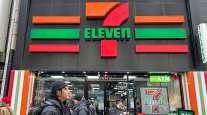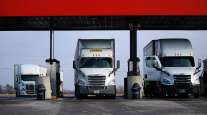Diesel Fuel Price Average Reaches $3.949 After Third Straight Increase
This story appears in the Aug. 1 print edition of Transport Topics.
U.S. retail diesel prices rose for the third consecutive week, increasing 2.6 cents a gallon to a national average of $3.949, the Department of Energy reported.
Although diesel is now 17.5 cents below its nearly three-year high set in early May, it is $1.03 a gallon higher than a year ago, DOE said after its July 25 survey of fueling stations. The average has risen 9.9 cents over the past three weeks.
The retail gasoline average also increased in the week to $3.699, a 1.7-cent rise, the fourth straight weekly increase. Gas has risen 12 cents since July 4 and remains well above the year-ago average of $2.749.
Crude oil futures on the New York Mercantile Exchange remained relatively stable, dipping slightly from the previous week, closing at $97.44 on July 28.
Although crude briefly fell to about $90 a barrel at the end of June, it has largely remained in a range between about $97 and $102 since early May.
The current price rise “is due to the price rise of crude oil,” said John Duff, an analyst with DOE’s Energy Information Administration. “But it’s further exacerbated by stronger demand for diesel that’s keeping that price of diesel higher than gasoline and causing it to not fall as quickly when crude oil prices recede.”
Duff added that strong worldwide demand for diesel is leading to more of the fuel being exported from the United States, which is keeping its price higher than gasoline.
Although an official at Karl Johnson Trucking, Lyndonville, Vt., said it equips all 60 of the carrier’s trucks with auxiliary power units, the real fuel-cost saver is its driver fuel incentive bonus program, said Karl Johnson, its director of operations.
“We set a mile-per-gallon target that we wanted to attain and felt could be attained,” Johnson said. “What we do is we take the mileage for each truck and the fuel burned for each truck for that month. For every dollar that that driver saves, we give him 20 cents back.”
“Our fuel mileage went up probably four-tenths of a mile to the gallon on fleet average. The program saves us about $50,000 a month.”
Janet White, fuel manager for Royal Trucking, West Point, Miss., said her carrier also has a driver incentive program. A computer program monitors the flatbed and dry van carrier’s drivers for such factors as idling, miles per gallon, time on cruise control and over speeding.
Drivers who operate the company’s 100 tractors most efficiently are given bonuses ranging from cash to televisions and shirts and caps.
“We have a fuel management group that meets a couple of times a month,” White said. “We counsel the drivers who are not in our target range.”
White said she also monitors fuel prices daily, buying in bulk when prices show a downward trend.
“No one really knows what the price of fuel is going to do,” White said. “But after you watch the patterns for years, you start to see trends and develop a sixth sense on what it’s going to do.”
Volatile diesel prices are challenging even some of the largest carriers that just reported solid second-quarter earnings numbers.
For example, truckload carrier Knight Transportation, Phoenix, said that escalating fuel prices continued to hurt the company’s operating results as its fuel surcharge programs were “largely deficient” in offsetting higher fuel costs.
Fuel surcharge programs failed to consider fuel usage such as idle time, empty miles and out-of-route miles driven, according to Knight.
“We continue to mitigate the effects of rising fuel expense by effectively managing our fuel miles per gallon with an intense focus on reducing idle time, managing out-of-route miles, and improving the driving habits of our driving associates,” said Kevin Knight, Knight’s chairman and CEO.
“We also continue to update our fleet with more fuel efficient . . . engines and to install aerodynamic devices on our tractors and trailer blades on our trailers which lead to meaningful fuel efficiency improvements.”
Likewise, UPS Chief Financial Officer Kurt Kuehn said that the company’s fuel costs increased by 12.6% during the second quarter.
“As high energy costs continue to prevail, we are vigilant in the pursuit to reduce usage, and UPS continues to evaluate a wide array of solutions, including various operational technologies, alternative fuels, and new vehicle designs,” Kuehn said.




